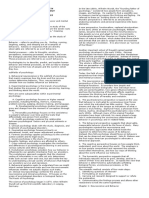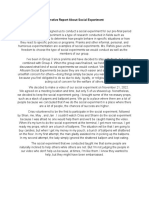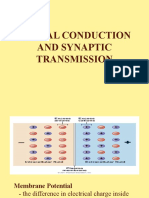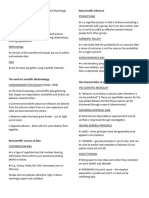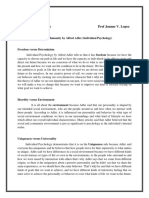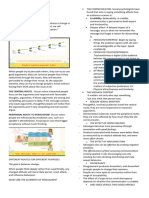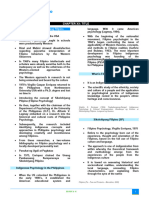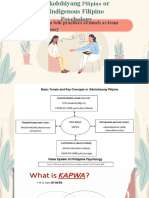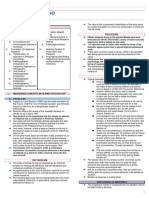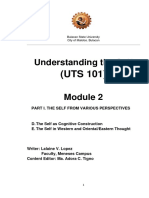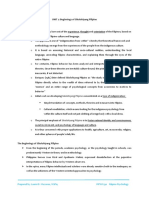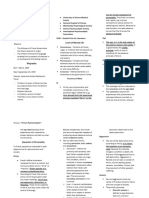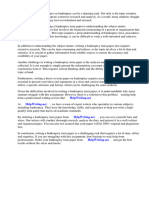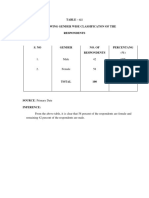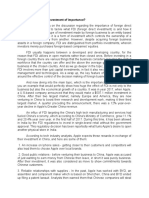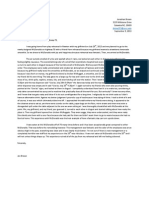Chapter 08- Solving Problems: Controlling Extraneous Variables
Extraneous Variable A cautionary note
A variable that is not the focus of an “When you design your procedures, do not
experiment but can confound effects on the sacrifice internal validity for external validity
dependent variable if not controlled. because internal validity is more important.
1. Physical Variables You cannot have external validity unless a study,
first, has internal validity!”
2. Social Variables
3. Personality Variables Social Variables
It pertains to the qualities of the
4. Context Variables relationships between subjects and
Physical Variables experimenters that can influence the
results of an experiment.
Are aspects of the testing conditions that
need to be controlled: 2 Principal Social Variables
1. Day of the week 1. Demand Characteristics
2. Experimental room 2. Experimenter Bias
3. Lighting 1. Demand Characteristics
Aspects of the experimental situation
4. Noise that demand or elicit particular behavior.
Specific cues in experimental research
3 Physical Variables techniques that may inadvertently influence a
1. Elimination subject’s response or behavior in an
A technique to control extraneous experiment.
variables by removing them from an Example:
experiment. (e.g., soundproofing a
room) people's behavior in elevators, where they avoid
eye contact with strangers.
2. Constancy of Conditions
Controlling Demand Characteristics:
A control procedure used to avoid
confounding; A. Single-Blind Experiments
keeping all aspects of the treatment An experiment in which subjects
conditions identical except for the are not told which of the
independent variable that is being treatment conditions they are in.
manipulated.
B. Placebo Effect
3. Balancing A subject receives an inert treatment
A technique used to control the and improves because of positive
impact of extraneous variables by expectancies
distributing their effects equally Change in subjects’ behavior simply
across treatment conditions. b/c the subjects expect an effect to
occur.
TAKE THESE PRECAUTIONS: C. Cover Story
A plausible but false explanation of the
Eliminate extraneous variables procedure in an experiment told to
whenever you can. disguise in actual research hypothesis
Keep treatment conditions as similar as so that subjects will not guess what it is.
possible.
Balance out the effects of other 2. Experimenter Bias
variables, such as the testing room, by Any behavior of the experimenter that
making sure that the effects are
can create confounding in an
distributed evenly across all treatment
experiment.
conditions.
Be sure to assign individual subjects to Rosenthal effect (Pygmalion effect)
treatment conditions at random.
The phenomenon of experimenters
treating subjects differently
depending on what they are in;
This is also called the Pygmalion
effect and self-fulfilling prophecy.
1
�Chapter 08- Solving Problems: Controlling Extraneous Variables
Controlling Experimenter Bias: If you use a convenience sample, your
results might not be generalizable
Double-Blind Experiments beyond these subjects.
An experiment in which neither the It is always best to use people you do
experimenter nor the subjects know not know.
which treatment condition the subjects
are in; Avoid pitfalls such as using unfamiliar
Used to control experimenter bias. subjects, constructing a random
selection procedure, and maintaining
Personality Variables uniform demeanor throughout the
The personal characteristics that an selection process.
experimenter or volunteer subject o Assigning subjects to conditions
brings to the experimental setting.
can have similar pitfalls.
Experimenters
In field experiments, avoid assigning
Personal characteristics the "nice" subjects to easier conditions and
experimenter brings to the "nasty" subjects to different conditions.
experimental setting (nice, friendly
o The best way to control for this
experimenter vs. cold, rude
possibility is to design an
experimenter).
assignment procedure, and stick
Important to maintain consistency with it.
across subjects and treatments.
Some Folklore About Subjects
Volunteer Subjects
There is the notion that sometimes,
Tend to be more sociable and score subjects contacted early in an
higher in social desirability experiment behave differently from
subjects contacted later.
Hold more liberal social and political
attitudes and less authoritarian, than Experimenters need to be aware of the
non-volunteer. possibility that they can show practice
and fatigue effects over the course of
Score higher on intelligence tests on running the entire experiment (i.e., less
the average, than non-volunteer. interested or bored).
Context Variables Best advice is to minimize face-to-face
Extraneous variable stemming from contact. This will have less impact on
procedures created by the environment, how subjects behave.
or context, of the research setting.
2 Basic Kinds of Context Variables
1. When the Subjects Select the Experiment
The researchers must keep the names
(titles) neutral to avoid getting a biased
sample because it reduces the ability to
generalize findings (less external
validity).
Subjects may decide not to participate
after the experiment is explained, and
• Always keep a record of
subjects who drop out (and what
condition of the experiment they
were assigned to) for your
research report.
2. When the Experimenter Selects the
Subjects
Keep in mind that some subjects who
volunteer probably will miss their
sessions for a variety of reasons (Friday
sessions are notorious for no-shows).
If you do not select your subjects
randomly, your sample will be biased.




